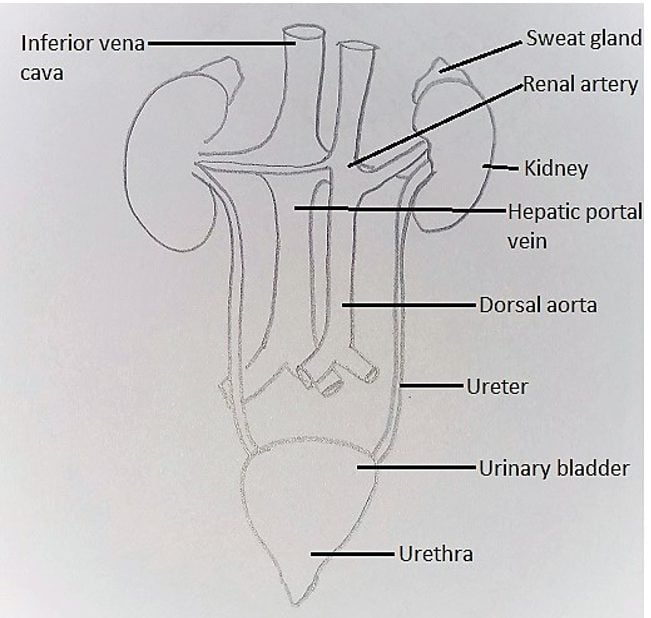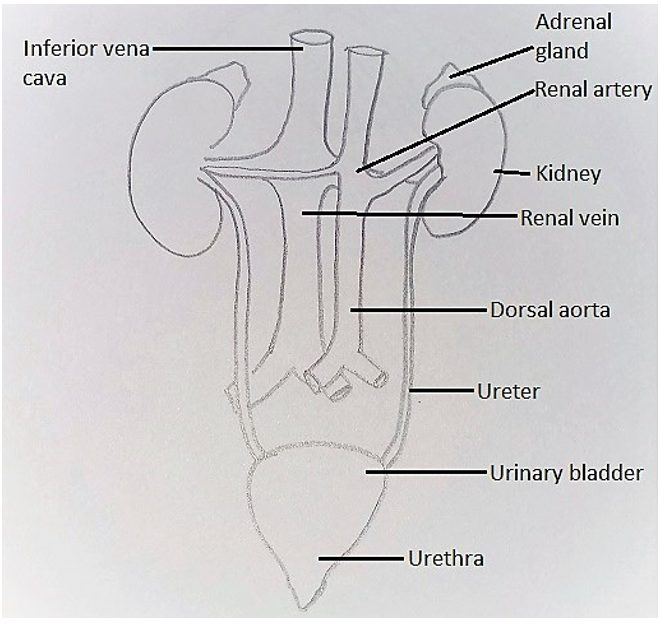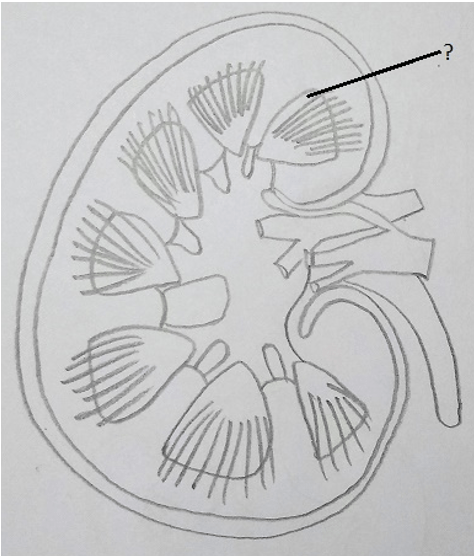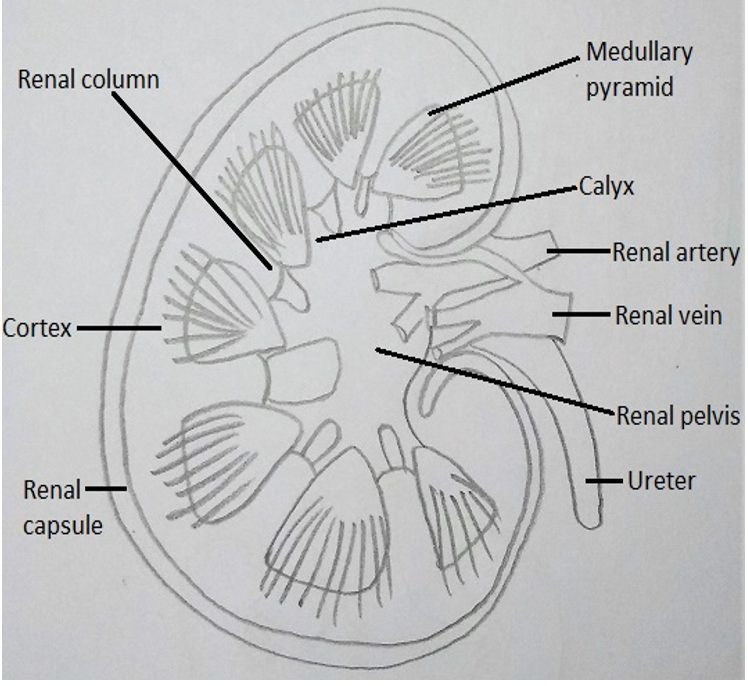This set of Class 11 Biology Chapter 19 Multiple Choice Questions & Answers (MCQs) focuses on “Excretory Products and their Elimination”. These MCQs are created based on the latest CBSE syllabus and the NCERT curriculum, offering valuable assistance for exam preparation.
1. Which of the following is not included in the excretory system of humans?
a) Cloaca
b) Kidneys
c) Ureters
d) Urethra
View Answer
Explanation: In humans, the excretory system consists of a pair of kidneys, one pair of ureters, a urinary bladder, and urethra. Kidneys are reddish-brown and bean-shaped structures.
2. Where are the kidneys situated?
a) Between the 7th and 10th ribs
b) Between the last thoracic and third lumbar vertebra
c) Between the 8th and 9th ribs
d) Between the first and second thoracic vertebra
View Answer
Explanation: Kidneys are reddish-brown, bean-shaped structures situated between the levels of the last thoracic and third lumbar vertebra close to the dorsal inner wall of the abdominal cavity.
3. What is the average weight of a human kidney?
a) 40 g
b) 100 g
c) 120 g
d) 10 g
View Answer
Explanation: Each kidney of an adult human measures for about 10-12 cm in length, 5-7 cm in width, and 2-3 cm in thickness with an average weight of 120-170 grams.
4. Through which of the following nerves and blood vessels enter the kidneys?
a) Hilum
b) Tubules
c) Pelvis
d) Medulla
View Answer
Explanation: Through the hilum, the nerves, the ureters and the blood vessels enter the kidneys. The hilum is a notch which is present towards the centre of the inner concave surface of the kidney.
5. Inside the kidney, there are three zones.
a) True
b) False
View Answer
Explanation: The outer layer of the kidney is a tough capsule. Inside the kidney, there are two zones, an outer cortex, and an inner medulla. Inner to the hilum, a broad funnel-shaped space is presently called the renal pelvis.
6. Which of the following is responsible for the formation of Columns of Bertini?
a) Medulla
b) Renal pelvis
c) Calyces
d) Cortex
View Answer
Explanation: Cortex is mainly responsible for the formation of columns of Bertini. The portion of the cortex which extends in between the medullary pyramids as renal columns form the columns of Bertini. The medulla region of the kidney is divided into a few conical masses called medullary pyramids which project into the calyces.
7. Which of the following is incorrectly marked in the given diagram?

a) Renal artery and inferior vena cava
b) Hepatic portal vein and sebaceous gland
c) Dorsal aorta and ureter
d) Urinary bladder and urethra
View Answer
Explanation: The correct labelling of the given diagram is as shown below:

The given diagram represents the human urinary system. The human urinary system is a complex excretory system which is responsible for the concentration of urine and elimination of urea from the body.
8. How many nephrons are present in each kidney?
a) One million
b) One billion
c) One trillion
d) Two million
View Answer
Explanation: Each kidney has approximately one million complex tubular structures called nephrons. These nephrons are the structural and functional units of the kidneys.
9. In how many parts a nephron is divided?
a) One
b) Two
c) Three
d) Four
View Answer
Explanation: Each nephron is divided into two parts- the glomerulus and the renal tubule. The glomerulus is a tuft of capillaries while the renal tubule begins with a double-walled cup-like structure called Bowman’s capsule.
10. What will happen if the diameter of the afferent arteriole is less than efferent arteriole?
a) Dilute urine
b) Concentrated urine
c) No ultrafiltration
d) Black urine
View Answer
Explanation: The afferent arteriole is a fine branch of the renal artery which has ha wider lumen than the efferent arteriole which carries blood away from the glomerulus. If the afferent arteriole diameter is less than the efferent arteriole, then ultrafiltration is not possible.
11. What does the question mark represents in the given figure?

a) Cortex
b) Medulla
c) Medullary pyramid
d) Renal pelvis
View Answer
Explanation: The correct labelling of the given figure is as shown:

This figure represents the longitudinal section or a diagrammatic view of a kidney.
12. Starfishes are aminotelic organisms.
a) True
b) False
View Answer
Explanation: Starfishes are aminotelic organisms as they excrete amino acids directly into the urine. Hippuric acid is an excretory waste formed by the combination of benzoic acid and glycine in mammals.
13. What are osmoregulators?
a) Animals which cannot change their body osmolarity
b) Animals which can change their osmolarity sometimes
c) Animals which can change their osmolarity
d) Animals which cannot excrete out waste
View Answer
Explanation: Osmoregulators are the animals that cannot change their body osmolarity according to their external environment. They cannot tolerate a wide range of salinity.
14. Which of the following organism is not an osmoconformer?
a) Hagfish
b) Spongilla
c) Marine invertebrates
d) Skates
View Answer
Explanation: Osmoconformers are the animals that can change their body osmolarity according to the external environment like hagfish, marine invertebrates, sharks, and skates.
15. Which of the following is not an adaptation of kangaroo rat?
a) Drinks water
b) Feeds on fatty seeds
c) Excretes concentrated urine
d) The nasal counter current system
View Answer
Explanation: Kangaroo rat does not drink water as it feeds on fatty seeds because 1g of fat oxidation produces a double amount of water. It excretes out concentrated urine and has a nasal counter current system.
More MCQs on Class 11 Biology Chapter 19:
- Chapter 19 – Excretory Products and their Elimination MCQ (Set 2)
- Chapter 19 – Excretory Products and their Elimination MCQ (Set 3)
- Chapter 19 – Excretory Products and their Elimination MCQ (Set 4)
- Chapter 19 – Excretory Products and their Elimination MCQ (Set 5)
- Chapter 19 – Excretory Products and their Elimination MCQ (Set 6)
- Chapter 19 – Excretory Products and their Elimination MCQ (Set 7)
- Chapter 19 – Excretory Products and their Elimination MCQ (Set 8)
- Chapter 19 – Excretory Products and their Elimination MCQ (Set 9)
To practice all chapters and topics of class 11 Biology, here is complete set of 1000+ Multiple Choice Questions and Answers.
If you find a mistake in question / option / answer, kindly take a screenshot and email to [email protected]
- Practice Class 11 - Physics MCQs
- Practice Class 11 - Mathematics MCQs
- Check Class 11 - Books
- Practice Class 11 - Chemistry MCQs
- Practice Class 12 - Biology MCQs
